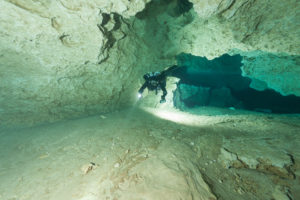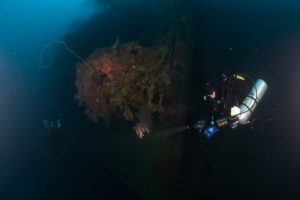Ever wondered how to best prepare for a technical dive? Or what an M-value is? In this, the fourth installment of our tech diving ABCDs we’ll cover topics starting with the letter M for M-value and going through P for preparation. (Check out the ABCDs, E through H, and I through L).
M is for M-value
The M-value is the highest degree of over-pressurization our tissues can withstand without problematic bubbles forming and potentially leading to decompression sickness. What? Ok, let’s take a step back here. On every single dive, our bodies/tissues absorb nitrogen as we descend and stay at depth. On the way up, atmospheric pressure drops, and our tissues off-gas nitrogen. Even after safety and decompression stops this process continues, with tissues containing nitrogen at a higher pressure than the atmosphere surrounding the diver. The M-value dictates how much higher the tissue-pressure can be in relation to the diver’s surroundings. Captain Robert Workman of the U.S. Navy Experimental Diving Unit first coined the term and went on to develop a full decompression model around the concept. While we’ve since superseded the model, the M-value concept remains in use by modern decompression models.
N is for Normoxic
The term normoxic describes a gas with a ‘normal’ content of oxygen. In technical diving, we apply it to trimix, which is a mix of oxygen, nitrogen and helium. Normoxic trimix has a normal content of oxygen, typically between 18 and 21 percent, which we can safely breathe at the surface. We can generally dive normoxic trimixes to 213 feet (65 m), based on their oxygen content. Their helium content will heavily influence the density of the gas as well as the degree of narcosis a diver feels.
Further along the scale, divers planning deeper dives may opt for hypoxic trimix. Cast your mind back to the letter H of this alphabet series, which described the difference between ‘hyperoxia’ — too much oxygen — and ‘hypoxia’ — too little oxygen. Hypoxic trimix is any mix with less than 18 percent of oxygen. Put (overly) simply, the lower the oxygen content, the deeper you can breathe a gas, although not safely at the surface. In those cases, divers utilize travel gas, which they can breathe on the journey to and from depth.
O is for Overhead Environments

Overhead environments are the most challenging places to dive for technical divers. Safely diving here requires specialized training and equipment. Generally speaking, we divide overhead environments between wrecks and caves, with mines somewhere in between. Diving these environments can be incredibly rewarding.
The main difference between these dives and technical dives on reefs or recreational dives is that the diver cannot return directly to the surface as there is a ‘hard ceiling’ above their head. This means the diver must deal with any problems happening inside the wreck or the cave right there and then — at least until they can start exiting. Problem solving takes time, and time requires gas reserves. Overhead divers must plan not just for the depth of their dive but also for the distance they need to travel to their exit point.
Navigation inside wrecks or caves can be tricky as well. The interiors of caves can resemble labyrinths in layout, and a line guiding the diver back to the exit is essential. Silt is another consideration: both wrecks and caves may have a layer of silt which, if a diver stirs it up, can lead to zero-visibility situations.
Wrecks are generally less stable than caves and divers must be extra careful when assessing potential penetration sites. The list of considerations goes on, but one thing is key: divers must thoroughly train and prepare for overhead dives.
P is for Preparation

Technical divers put a huge focus on their dive preparations, which may start days, if not weeks, before the dive. Tech divers must research conditions on the sites, ensure the required gases are available, arrange roles within a dive team, gather equipment, and so much more. Some considerations for dive planning include broader areas like logistics and the distance to the nearest recompression chamber. Others include the minute details of the dive, such as bottom time and individual staged-decompression stops. Tech divers must also consider their exposure to oxygen, especially if they conduct dives on rebreathers with long runtimes. The dive objective is another consideration, as is the level of expected gas narcosis and so much more.
Preparation for dives is a large part of any tech diving course and something that we continue to apply to any subsequent tech dives following certification. Stay tuned for the next article in our series, addressing the letters Q through T.

